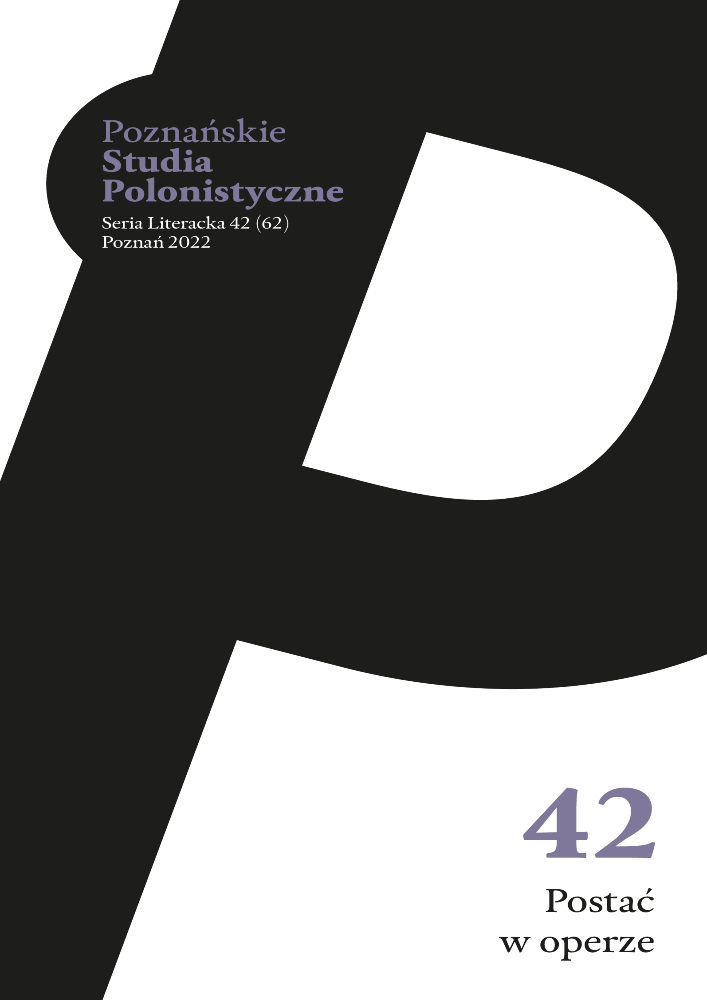Abstrakt
This study presents the historical range of topics related to the typology of singing voices and how they are linked to the character constituting the building material of an operatic character. This six-part overview presents the subsequent stages of the formation of the status and role of particular voices in the theory and practice of musical performance, with particular emphasis on specific vocal phenomena key to the development of operatic and solo singing: the so-called covering, haute-contre, bass-baritone and boy soprano. The reason behind the diachronic presentation of the vocal terms is to order and systematise the transformations that vocal practice, musical nomenclature and musical performance have undergone over the centuries.
Bibliografia
Anonim (1765), Voix [hasło], w: Encyclopédie de Diderot et d’Alembert, vol. 17, s. 428a–432a, Paris, [dostęp: 16 czerwca 2022], https://tinyurl.com/5b2c95dh.
Berlioz Hector (1872), A travers chants: études musicales, adorations, boutades et critiques, Calmann Lévy, Paris.
Campana Alessandra (1991), Mozart’s Italian Buffo Singers, „Early Music”, vol. 19, nr 4, s. 580–583, [dostęp: 7 czerwca 2022], https://www.jstor.org/stable/pdf/3127919.pdf.
Cannon Robert (2012), Appendix 2 – The Development of Singing Voice in Opera, w: Robert Canon, Opera, Cambridge University Press, Cambridge, s. 389–393, https://doi.org/10.1017/CBO9780511980558.024.
Carducci Edgardo (1930), The Tenor Voice in Europe, „Music and Letters”, vol. 11, nr 4, s. 318–324, https://doi.org/10.1093/ml/XI.4.318.
Cyr Mary (1977), On Performing 18th-Century Haute-Contre Roles, „The Musical Times”, vol. 118, nr 1610, s. 291–295, https://doi.org/10.2307/958048.
Ehrmann-Herfort Sabine, Seedorf Thomas (1997), Stimmengattungen [MGG], Sachteil, t. 20, Kassel i in., Bärenreiter, szp. 1775–1811.
Emerson Isabelle (2005), Five Centuries of Women Singers, Praeger, Westport.
Fallows David i in. (2001), Tenor [GMO], https://doi.org/10.1093/gmo/9781561592630.article.27667.
Finscher Ludwig, Owens Jessie Ann J. A. (1997), Singen [MGG], t. 20, szp. 1412–1470.
Flotzinger Rudolf, Sanders Ernest H., Lefferts Peter M. (2001), Discant [GMO], https://doi.org/10.1093/gmo/9781561592630.article.07839.
Framery Nicolas Etienne (1818), Encyclopedie méthodique…, t. 2: Musique, Panckoucke, Paris.
García Manuel (1924), Treatise on the Art of Singing, red. Albert García, Leonard & CO, London.
Harris Ellen T. (2001), Mezzo-contralto [GMO], https://doi.org/10.1093/gmo/9781561592630.article.18569.
Hughes Andrew (1969), Some Notes on the Early Fifteenth-Century Contratenor, „Music and Letters”, vol. 50, z. 3, s. 376–387, https://doi.org/10.1093/ml/L.3.376.
Jander Owen, Harris Ellen T. (2001), Alto (i) [GMO], https://doi.org/10.1093/gmo/9781561592630.article.00693.
Jander Owen, Harris Ellen T. (2001), Bass-baritone [GMO], https://doi.org/10.1093/gmo/9781561592630.article.02234.
Jander Owen i in. (2001), Contralto [GMO], https://doi.org/10.1093/gmo/9781561592630.article.06365.
Jander Owen (2001), Contratenor altus [GMO], https://doi.org/10.1093/gmo/9781561592630.article.06372.
Jander Owen i in. (2002), Baritone [GMO], https://doi.org/10.1093/gmo/9781561592630.article.O008400.
Kloiber Rudolf, Konold Wulf, Maschka Robert (2011), Handbuch der Oper, Bärenreiter Verlag, Kassel.
Miller Richard (2000), Training Soprano Voices, Oxford University Press, Oxford.
Miller Richard (2008), Securing Baritone, Bass-Baritone, and Bass Voices, Oxford University Press, Oxford.
Pavis Patrice (2002), Słownik terminów teatralnych, przełożył, opracował i uzupełnieniami opatrzył Sławomir Świontek, Ossolineum, Wrocław.
Quantz Johann Joachim (1754), Herrn Johann Joachim Quantzens Lebenslauf, von ihm selbst entworfen, w: Wilhelm Marpurg, Historisch-Kritische Beyträge zur Aufnahme der Musik, Erstes Stück, Berlin, s. 197–250.
Reckow Fritz, Roesner Edward H. (2001), Organum, §1: Etymology, Early Usage [GMO], https://doi.org/10.1093/gmo/9781561592630.article.48902.
Riggs Geoffrey S. (2003), Assoluta Voices in Opera 1797–1847, McFarland & Company, Jefferson.
Rohringer Stefan (2012), Don Ottavio and the History of the Tenor Voice, w: Dramma Giocoso: Four Contemporary Perspectives on the Mozart/Da Ponte Operas, Leuven University Press, Leuven, s. 33–58, https://doi.org/10.2307/j.ctt9qdwt6.
Rousseau Jean Jacques (1765), Voix, w: Encyclopédie de Diderot et d’Alembert, vol. 17, s. 436a–437a, Paris, [dostęp: 19 grudnia 2021], https://tinyurl.com/4nu4s27j.
Rousseau Jean Jacques (1768), Dictionnaire de musique, Paris, [dostęp: 19 grudnia 2021], https://tinyurl.com/k78j868j.
Smith Norman E. i in. (2001), Organum [GMO], https://doi.org/10.1093/gmo/9781561592630.article.48902.
Stark James (1999), Bel Canto: A History of Vocal Pedagogy, University of Toronto Press, Toronto.
Straburzyński Michał (2007), Głos bas-barytonowy jako odrębny rodzaj głosu ludzkiego, [praca dyplomowa], Akademia Muzyczna im. I. J. Paderewskiego, Poznań.
Vest Jason Christopher (2009), Adolphe Nourrit, Gilbert-Louis Duprez, and Transformations of Tenor Technique in the Early Nineteenth Century: Historical and Physiological Considerations, Lexington, Kentucky.
Vignal Marc, red. (2005), Dictionnaire de la musique, Larousse, Paris.
Wydra Wiesław, Rzepka Ryszard, wybór i oprac. (1984), Chrestomatia staropolska. Teksty do roku 1543, Ossolineum, Wrocław.
Zaslaw Neal (1974), The Enigma of the Haute-Contre, „The Musical Times”, vol. 115, nr 1581, s. 939–941, https://doi.org/10.2307/958179.
Licencja
Autorzy
Autorzy tekstów przyjętych do publikacji w czasopiśmie „Poznańskie Studia Polonistyczne. Seria Literacka” są zobowiązani do wypełnienia, podpisania i odesłania na adres redakcji umowy o udzielenie nieodpłatnej licencji do utworów, z zobowiązaniem do udzielania sublicencji CC.
Zgodnie z umową, autorzy tekstów opublikowanych w czasopiśmie „Poznańskie Studia Polonistyczne. Seria Literacka” udzielają Uniwersytetowi im. Adama Mickiewicza w Poznaniu niewyłącznej i nieodpłatnej licencji oraz zezwalają na użycie sublicencji Creative Commons Attribution-NoDerivatives 4.0 International (CC BY-ND 4.0).
Autorzy zachowują prawa do dalszego, swobodnego rozporządzania utworem.
Użytkownicy
Zainteresowani użytkownicy internetu uprawnieni są do korzystania z utworów opublikowanych od 2016 roku w „Poznańskich Studiach Polonistycznych. Serii Literackiej” pod następującymi warunkami:
- uznanie autorstwa – obowiązek podania wraz z rozpowszechnionym utworem, informacji, o autorstwie, tytule, źródle (odnośniki do oryginalnego utworu, DOI) oraz samej licencji;
- bez tworzenia utworów zależnych – utwór musi być zachowany w oryginalnej postaci, nie można bez zgody twórcy rozpowszechniać np. tłumaczeń, opracowań.
Do wszystkich tekstów opublikowanych przed 2016 r. prawa autorskie są zastrzeżone.
Inne
Uniwersytet im. Adama Mickiewicza w Poznaniu zachowuje prawo do czasopisma jako całości (układ, forma graficzna, tytuł, projekt okładki, logo itp.).

